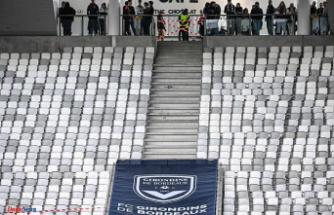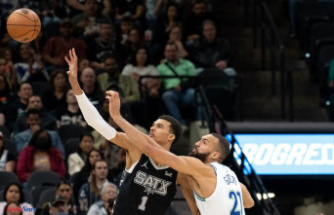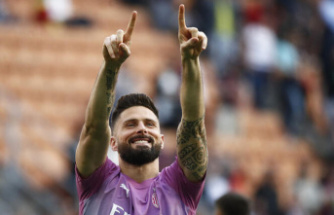The group stage of the European Football Championship isn't even over yet, but three players are already out due to cruciate ligament tears. An accumulation that actually has a gender-specific cause. Women are at a much higher risk of suffering such a knee injury.
She takes a step forward, grabs her right knee and sinks onto the lawn, her face contorted in pain. It's only 14 minutes into the European Championship game between co-favourites France and Belgium when Marie-Antoinette Katoto, France's star striker, first has to be treated and then replaced. Completely alone, without any contact with an opponent and without having made any abnormal movement, she falls to the ground. The 23-year-old from Paris St.-Germain spent the rest of the game on the substitutes' bench with an ice pack on her knee, leaving the stadium on crutches after the 2-1 win.
What coach Corinne Diacre tries to downplay right after the game is hard certainty the next day: Katoto tore his anterior cruciate ligament and injured his meniscus. After two games, the European Championship is over for them.
World footballer Alexia Putellas, who tore her cruciate ligament in training just one day before the opening ceremony, was unable to play at all. Stars on crutches instead of with the ball on their feet. They share fate with Simone Magill. The Northern Irishwoman was injured in the first game against Norway. "I knew it straight away," Magill said, according to the Belfast Telegraph. "I'm not one to get down for the sake of it. I felt something was gone and I started hitting the ground because I knew what it meant. I was angry, I was frustrated and I I was in pain, but most of all I was heartbroken."
The German team is also missing a big one: Dzenifer Marozsán. The 111-time national player tore her cruciate ligament in April in the World Cup qualifier against Serbia. She not only missed the European Championship, but also the Champions League final, which her team, Olympique Lyon, finally won against FC Barcelona without her.
Three cruciate ligament tears after two matchdays, the failure rate at this European Championship due to this type of injury alone is high. Research has shown that women are much more likely to suffer a cruciate ligament tear. It occurs about four to five times more often in female professional athletes compared to their male counterparts, says Dr. Henning Ott, specialist in orthopedics and trauma surgery, to ntv.de.
Of course, football is one of the sports that are known to cause cruciate ligament tears, just like volleyball, handball, basketball and skiing. Jumps and changes of direction are a risk factor, all athletes want as much grip on the ground as possible. Everything that fixes the foot is the cause of the introductory movement of a cruciate ligament tear, Ott explains. The knee buckles inwards or forwards, the anterior cruciate ligament, which is just as important for the rotation and movement of the tibial plateau, can tear.
But why so common in women? Science is researching this. One reason is that there is a gender difference in muscle mass, says Dr. Benjamin Bartek, specialist in orthopedics and trauma surgery at the Center for Musculoskeletal Surgery at the Charité Berlin. "The stronger the muscles that surround a joint, the better protected it is." The fact that women have less muscle mass is not due to poorer training, even with the same level of performance, biology simply makes a difference.
Anatomy also plays a major role. Women are more likely to have a different leg position than men. They tend to have knock knees, while men tend to have bow legs. In addition, a so-called functional knock knee is more common, which means that the functional leg axis cannot be held muscularly and the knee buckles inwards in the dynamic, Ott and Bartek explain in agreement. That is a "risk factor" per se. "Women jump and land differently, analyzes show that," explains Ott. "They jump into reserve more often and that increases the likelihood of a cruciate ligament rupture." There are ideas to prevent this if possible, to re-educate women so that they jump differently. Because of course it would be better if a cause of injury is avoided. But the approach was - not surprisingly - rejected as utopian.
Differences in the skeleton can also be a reason for the greater susceptibility to injury. The slope of the tibial plateau is increased in the female knee, according to Bartek. "If the so-called tibial slope is increased, I have a greater load on the anterior cruciate ligament, which is also a negative factor." Another influential detail also differs: the notch, the area in which the rear and front cruciate ligaments run and originate, is anatomically rather narrow in women and rather wide in men. The narrow notch also increases the risk of cruciate ligament injuries.
In addition to the anatomy, Ott sees an even bigger problem: In the top leagues for men, they are all professionals, they do nothing else. You have plenty of time to train. But the women often have to earn their money somewhere else. Many - outside the absolute top clubs - have an eight-hour day behind them when they come to training. "They have a lot less time for preventive training." In addition, they are already knocked out. of the day, even if it's just mentally, because her studies are challenging, which also leaves less free time than men have. Lagging behind in professionalization is therefore a reason for frequent injuries.
Kirsty Elliott-Sale, a professor at the Manchester Metropolitan University Institute of Sport, agrees. She told the Guardian: "In my opinion cruciate ligament injuries are multifactorial and stress can certainly have both direct and indirect effects on a player's health and performance." In the German team, most of the players study alongside football. There is hardly any time for regeneration or free time for idleness.
Hormones and the female cycle probably also play a role, and this topic is currently the subject of increasing scientific research. Ott, who was the team doctor at the Bundesliga soccer clubs TSG Hoffenheim and Eintracht Frankfurt and who recently opened the SPORTORTHO rheinmain practice, is familiar with two recent studies from 2021 and 2022 on the subject. In one, 156 cruciate ligament injuries from international female footballers were evaluated. "It has been shown that in the late follicular phase, i.e. just before ovulation, there is twice as much risk of injury as in the phase just before menstruation," says Ott, summing up. At the same time, there is another work on athletic training that shows that female athletes react better to regeneration and adaptation in the first phase of the cycle, where the apparently more injury-prone period also plays a role. "The first phase of the cycle seems to be both a blessing and a curse. On the one hand there is a better adaptation in training, but there is also a significantly higher phase for muscle and tendon injuries."
Once the cruciate ligament is torn, the athlete has to be patient for many months. "Six months is complete nonsense," says Ott clearly about the healing process that amateur athletes like to dream of. “Other professionals who have nothing to do other than training may manage six months. There are, however, two big buts: the ligament still doesn’t heal faster and we know that the cruciate ligaments need nine to twelve months to fully integrate,” says the sports medicine. "That's the biology and we can't change anything about it." He goes on to explain: "We also know that with every month that people are on the court before the ninth month after the operation, they significantly increase their risk." He therefore always makes it clear to all professionals: "Nine months, period." Bartek's approach is not quite as rigorous: "There is no greater punishment than following a game from the stands, so you have to find a good point. With the help of 'Return to competition' programs, relatively good, objective criteria can be found Find." However, he also sees seven to ten months downtime as realistic.
Plenty of time to ponder, but also to grow mentally. "This process will be quite challenging but I am confident that I will recover, get back on track and finish what I started," Putellas said. And Germany's midfield ace Sara Däbritz said of the "Guardian" looking back on her cruciate ligament injury in December 2019: "I felt that it made me stronger mentally and on the field."
It can't stop the pros from playing football, as numerous women and men prove, who have not given up even after several cruciate ligament ruptures. Putellas described it this way right after their misfortune: "The first thing that this situation confirmed for me is the genuine and pure love I feel for this sport. I could blame him. Why now? Why a day before The start of the European Championships that I've been looking forward to and working towards for so long? But I'm not. I feel like I've been privileged for a long time. I'm just grateful for this daily joy that's brought for everyone is so hard to reach."












